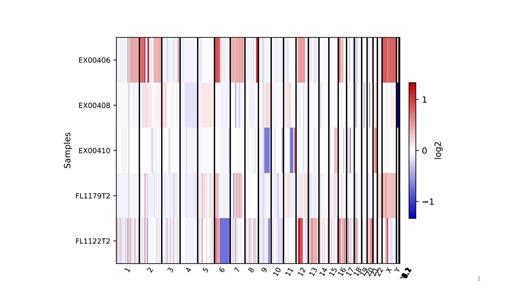Abstract
Objectives: We identified a case of follicular lymphoma (FL) that transformed into a morphologic diffuse large B-cell lymphoma (DLBCL), which by gene expression profiling showed a primary mediastinal (PMBL)-like gene expression profile (GEP) (Lymph3Cx; Blood 2018;132:2401-5). A search identified 4 additional transformed FL (tFL) cases with a PMBL-like GEP, which we further studied to determine how similar these tFLs were to classic cases of PMBL.
Methods: The morphology and previously reported immunophenotype were reviewed, and CD30, CD23, MAL, CD273/PDL2, and CD200 immunohistochemical stains (IHC) were performed. Whole exome sequencing (WES) and copy number analysis (CNA) to evaluate genes typically altered in FL and PMBL were performed.
Results: None of the tFLs arose in the mediastinum or had a previous history of mediastinal disease. All cases showed typical centroblastic DLBCL cytology, with fine sclerosis typical of PMBL. 3/3 were GCB by the Hans IHC algorithm, 1/3 were MYC+, 3/3 BCL2+, 1/5 CD30+, 3/5 CD23+, 4/5 MAL+, 0/5 CD273/PDL2+, 1/5 CD200+, and 0/2 EBER+. Rearrangements of MYC, BCL2, or BCL6 were identified by FISH in 0/3, 1/3, and 2/3 cases, respectively. WES demonstrated sequence variants in genes associated with both FL (CREBBP [60%], KMT2D [40%], and TNFRSF14 [40%]) and PMBL (JAK-STAT pathway genes [80%], B2M [20%], and CD58 [20%]). 2 of the mutations identified in the tFLs have previously been shown to result in JAK-STAT activation (STAT6 p.E372K [PNAS 2016;113:13015-20] and SOCS1 p.F101L [Oncogene 2002;21:4351-62] identified in 1/5 cases each). CNA showed gains/amplification of REL in 3/5 cases, gains/amplification of STAT6 in 2/5, gains of large sections of chromosome 16, including IL4R, in 2/5, and both deletions and gains of 11q in 1/5. See Figure demonstrating the 5 cases on the Y-axis and the chromosomes on the X-axis.
Conclusions: The tFLs in this small series seem to represent PMBL-like DLBCLs, rather than classic PMBLs, and have a blended pattern of immunophenotypic and genomic features between FL/DLBCL and PMBL. Although the cases express some PMBL-associated markers (CD23 and MAL), there is less frequent staining for others (CD30, CD273/PDL2, and CD200). The cases harbor both FL-associated and PMBL-associated sequence variants, including 40% with mutations known to activate the JAK-STAT pathway. This frequency of mutations in JAK-STAT pathway genes is higher than that seen in typical FL/DLBCL, but perhaps lower than in classic PMBL (Blood 2019;134:802-13). PMBL also frequently has gains/amplifications of 9p24.1, which was not seen in our cohort. However, gains/amplification of REL/2p, which is seen in approximately 50% of PMBL, was identified in 60% of the tFLs. The 11q aberration identified in 1 case would be unusual for PMBL, and is instead more commonly associated with a subset of aggressive lymphomas with Burkitt-like features (Haematologica 2019;104:1822-9). Recently, lymphomas with similar blended features between DLBCL and PMBL, which were not arising in the setting of tFL, have been reported (Duns G, et al. Blood 2021). Our study extends the types of biological transformations, in addition to more classic DLBCL, that can be seen in FL. These tFLs with blended PMBL-DLBCL biology may have implications for therapeutic decision making including targeted therapies used in PMBL.
Rimsza: NanoString Technologies: Other: Fee-for-service contract. Steidl: Curis Inc.: Consultancy; Trillium Therapeutics: Research Funding; Bayer: Consultancy; Epizyme: Research Funding; Seattle Genetics: Consultancy; AbbVie: Consultancy; Bristol-Myers Squibb: Research Funding.


This feature is available to Subscribers Only
Sign In or Create an Account Close Modal